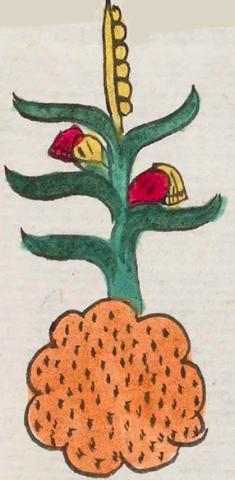Atocpan (Mdz29r)
This compound glyph for the place name Atocpan has two principal visual features, a maize plant (toctli) or tōctli, showing vowel length) and a scalloped circle of damp, fertile soil (atoctli or ātoctli). The maize plant, which is silent in the place name, is both flowering and it has ears of corn, an expression of its fertility. It has four branches, a yellow stalk of flowers at the top, and two ears of corn, one yellow with a red tassel and one red with a yellow tassel. The humid soil is a circular shape with a scalloped edge. It is orange or terracotta color, and it is textured with dots. The locative suffix (-pan) could be implied by the placement of the plant "on" the soil.
Stephanie Wood
The overlapping phonetic value of toctli and atoctli seem to fit what Gordon Whittaker calls "graphic syllepsis." The main point of the place name is to point to the humid soil, but there is a semantic overlap, because fertile soil also produces a healthy maize harvest. The hash marks on the corn cobs seem to anthropomorphize them, having the appearance of eyes. One of the murals in Cacaxtla, Puebla, shows a maize plant with cobs that have human faces and, where the hair of the head might be expected, the kernels appear. National Geographic has published a detail. The coloring of maize cobs as red and yellow echoes through many glyphs that feature them. See below, right. Also, red and yellow are key colors for indigenous corn in real life, and they likely have a religious meaning, too. See the short essay on the colors of interiors of the earth and human body.
Stephanie Wood
atocpan. puo
Atocpan, pueblo
Stephanie Wood
c. 1541, or by 1553 at the latest
Stephanie Wood
maize, corn, agriculture, fertile soil, humid soil, damp earth, irrigated land, irrigation, riego, maíz, agricultura, tierra fértil, tierra húmeda, nombres de lugares

atoc(tli) or ātoc(tli), humid fertile soil, https://nahuatl.wired-humanities.org/content/atoctli
toc(tli) or tōc(tli), a stalk of maize, https://nahuatl.wired-humanities.org/content/toctli
-pan (locative suffix), on or in, https://nahuatl.wired-humanities.org/content/pan
"On the Heavy, Damp, Fertile Land" (Karttunen accepts the interpretation of Berdan and Anawalt here) [Frances Karttunen, unpublished manuscript, used here with her permission.]
"On the Heavy, Damp, Fertile Land" (Berdan and Anawalt, 1992, vol. 1, p. 173)
"En la Tierra Húmeda y Fértil"
Stephanie Wood
Codex Mendoza, folio 29 recto, https://digital.bodleian.ox.ac.uk/objects/2fea788e-2aa2-4f08-b6d9-648c00..., image 68 of 188.
The Bodleian Libraries, University of Oxford, hold the original manuscript, the MS. Arch. Selden. A. 1. This image is published here under the UK Creative Commons, “Attribution-NonCommercial-ShareAlike 3.0 License” (CC-BY-NC-SA 3.0).




